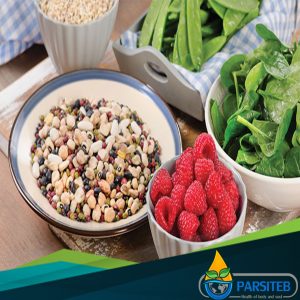Fiber can affect your health. Most people have a very basic understanding of it, and tend to lump it all into one category.

However, the truth is that not all fiber is created equal. Some types are highly beneficial, while others can cause digestive problems in some people.
This article explains everything you need to know about the different types of it.
What is Fiber and how is it Classified?

“Fiber” refers to a diverse group of carbohydrates that humans cannot digest.
We lack the digestive enzymes required to break them down, so they pass through most of the digestive system unchanged.
The recommended intake is 38 grams for men, and 25 grams for women. However, most people are only eating around half of that, or 15-17 grams per day.
it is mostly found in plant foods, including vegetables, fruits, legumes, whole grains, nuts and seeds.
Fiber is formally classified into two main types:

Dietary fiber: Fiber found naturally in foods.
Functional fiber: Fiber that is extracted and isolated from whole foods, then added to processed foods.
However, there is a major problem with classifying fiber in this way. It tells us absolutely nothing about their health effects.
A popular alternative method is to classify it based on its solubility (soluble vs. insoluble), viscosity (viscous vs. non-viscous) and fermentability (fermentable vs. non-fermentable).
Then there is yet another class of nutrients called resistant starches, which are often classified as dietary fibers.
Soluble vs. Insoluble Fiber

The solubility of it refers to its ability to dissolve in water.
Based on this, fiber has often been categorized as either soluble or insoluble:
- Soluble blends with water in the gut, forming a gel-like substance. It can reduce blood sugar spikes, and has various metabolic health benefits.
- Insoluble does not blend with the water and passes through the digestive system mostly intact. It functions mostly as a “bulking” agent, and may help speed the passage of food and waste through your gut.
- Soluble fibers include gums, pectins, psyllium, beta-glucans and others. Insoluble fibers include lignin and cellulose.
Different plant foods have varying proportions of soluble and insoluble fibers.
Fermentable Fiber

An estimated 100 trillion live bacteria reside in the human gut, mainly in the large intestine.
These bacteria are actually crucial for optimal health in humans. They play various roles related to weight management, blood sugar control, immunity, brain function and mental health.
They are so important that they are often referred to as the “forgotten organ”.
Because humans can’t digest fiber, it ends up reaching the large intestine mostly unchanged.
This is where fermentable fiber comes into play. These are fibers that the friendly gut bacteria are able to digest (ferment) and use as fuel.
Viscous Fiber

Some types of soluble fibers form a thick gel when they blend with water. These are known as viscous fibers.
Put simply, the viscosity of a fluid refers to its “thickness.” For example, the sweetener honey is more viscous than water.
When you eat viscous fiber, it forms a gel-like substance that “sits” in the gut.
This slows down the digestion and absorption of nutrients, resulting in a prolonged feeling of fullness and reduced appetite.
A review of 44 studies on fiber treatments found that only viscous fibers reduced food intake and caused weight loss.
Viscous fibers include glucomannan, beta-glucans, pectins, guar gum and psyllium. Good whole-food sources include legumes, asparagus, Brussels sprouts, oats and flax seeds.
Resistant Starch

Starches are the main types of carbohydrates in the diet.
They are long chains of glucose molecules, found in potatoes, grains and many other foods.
Some starch is actually resistant to digestion, so that it passes through the digestive system unchanged.
This type of starch is called resistant starch, and it functions like soluble, fermentable fiber in the gut.
Resistant starch has numerous powerful health benefits. It improves digestive health, enhances insulin sensitivity, lowers blood sugar levels and significantly reduces appetite.
There are several good food sources of resistant starch, including green bananas, various legumes, cashews and raw oats. A more detailed list can be found here.
Additionally, certain starchy foods tend to form large amounts of resistant starch if they are cooled down after cooking. This includes white potatoes and white rice.
Raw potato starch is also very high in resistant starch, and some people eat it as a supplement.
Reference: Healthline
Collected by: Dr. Sara Bakhshaei
 Parsi Teb Physical and Mental Health Journal
Parsi Teb Physical and Mental Health Journal 



